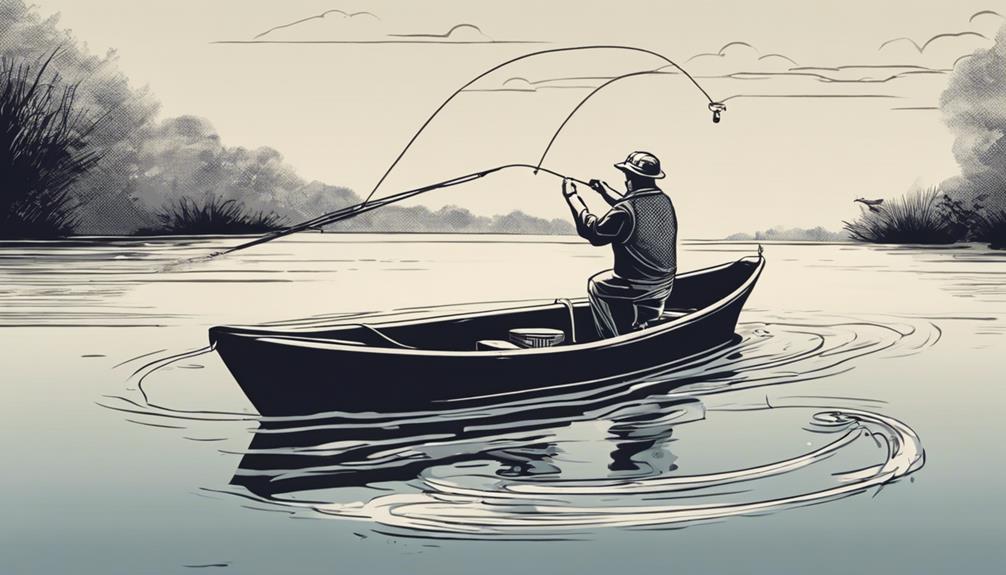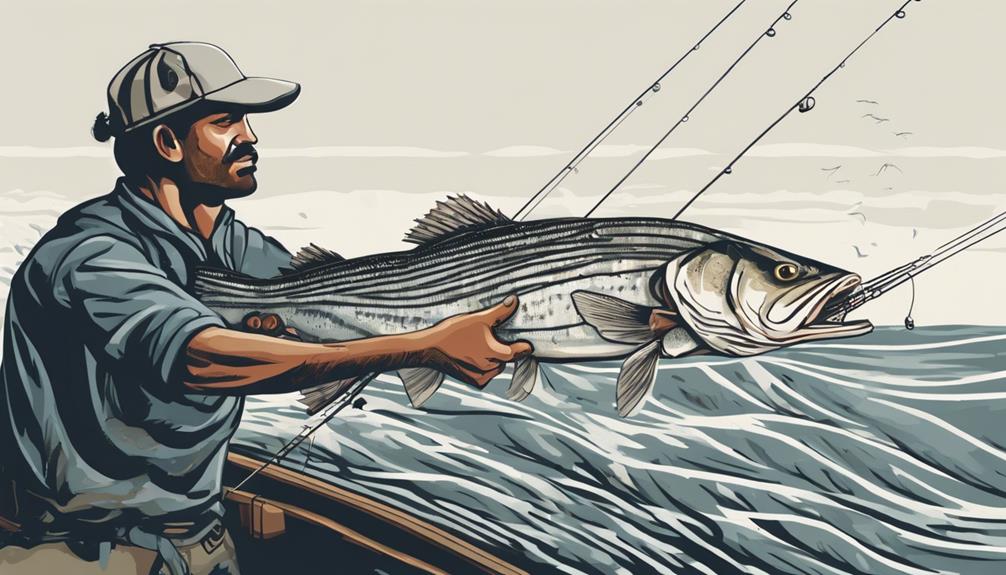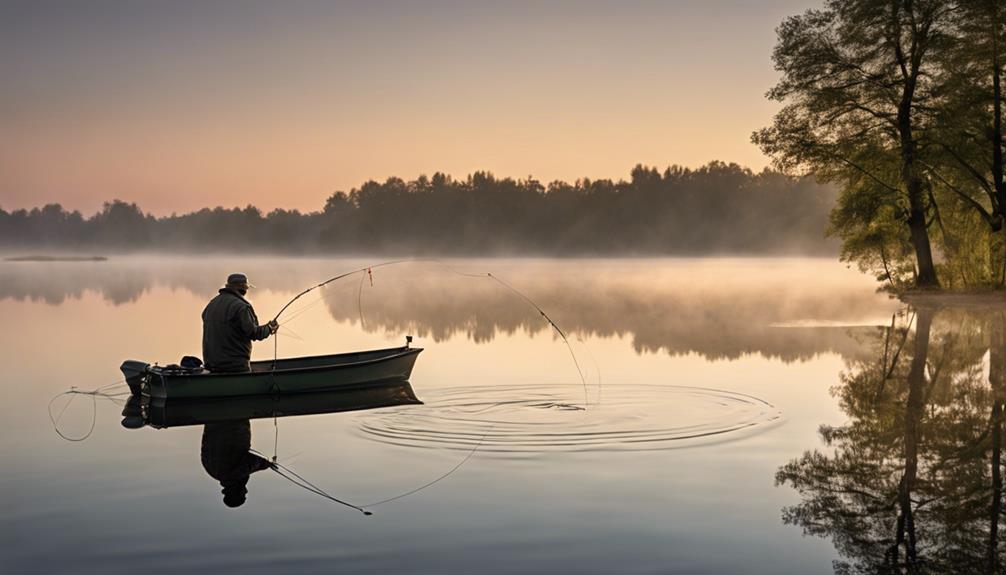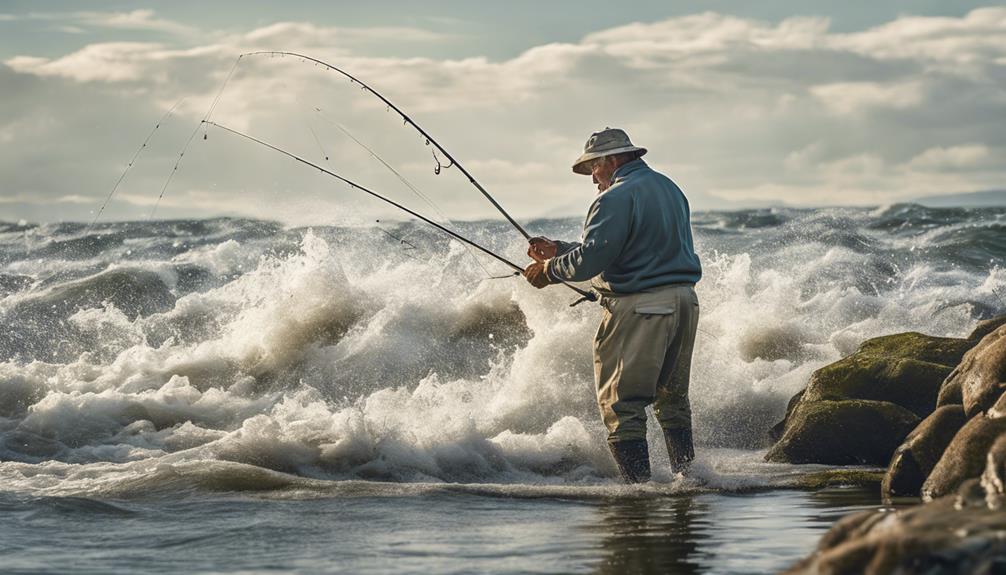Looking to improve your striped bass fishing game but not sure where to start? Have you considered the top 3 techniques that seasoned anglers swear by?
These methods are tried and tested, making them essential tools in your fishing repertoire. Whether you're a beginner or a seasoned pro, mastering these techniques could be the key to landing that trophy-sized bass you've been dreaming of.
Trolling With Diving Plugs
When trolling with diving plugs, adjust the depth based on the location of the Striped Bass to increase your chances of a successful catch. Deep diving artificial lures are essential for targeting Striped Bass that are holding at varying depths. These lures are designed to reach depths where the fish are actively feeding, making them highly effective in enticing strikes from these elusive creatures.
To start, ensure you have a selection of deep diving plugs in your tackle box. Vary the size and color to match the local baitfish, as this can significantly influence your success. When you begin trolling, pay close attention to your sonar to identify the depth at which the Striped Bass are suspended. Adjust the length of line you let out behind the boat to control the depth at which your lure is running. By fine-tuning this aspect of your setup, you can present your artificial lure at the optimal depth to attract the attention of the bass.
Remember to experiment with your trolling speed as well. Sometimes Striped Bass prefer a faster-moving target, while at other times, they may be more enticed by a slower presentation. By varying your speed and observing the fish's response, you can dial in the perfect approach to maximize your chances of a productive day on the water.
Jigging Near Structure
Adjust your technique when targeting Striped Bass near structure by employing the effective method of jigging. Structure exploration is key when jigging for Striped Bass. Look for underwater features such as rock piles, submerged trees, or drop-offs where Striped Bass are likely to hide. These structures provide cover and ambush points for the bass, making them prime locations for a successful jigging session.
When jigging near structure, it's crucial to focus on your bait presentation. Choose a jig that mimics the local baitfish in both size and color. Work your jig close to the structure, allowing it to flutter down naturally like an injured baitfish. The key is to entice the bass hiding in the structure to strike by making your jig look like an easy meal. Vary your jigging technique by mixing up the speed and depth of your jig to find what triggers the most strikes.
To maximize your chances of success, be prepared to lose some jigs when fishing near structure. While losing a few jigs is inevitable, the rewards of landing a big Striped Bass make it worthwhile. Remember, patience and persistence are essential when jigging near structure for Striped Bass. By mastering this technique, you'll increase your chances of hooking into some trophy-sized fish.
Live Bait Rigging
Exploring live bait rigging techniques can greatly enhance your success in catching Striped Bass. When it comes to live bait rigging for Striped Bass, there are a few key techniques you should consider incorporating into your fishing routine.
- Use Surface Poppers: Surface poppers are an excellent choice for attracting Striped Bass near the top of the water. These lures create a commotion on the surface that can entice bass to strike.
- Employ Fly Fishing Techniques: Fly fishing for Striped Bass can be highly effective, especially in shallow waters or when targeting feeding fish. Using flies that mimic baitfish can yield great results.
- Adjust Bait Depth: Depending on where the bass are located in the water column, you may need to adjust the depth at which your live bait is swimming. This can involve using weights or bobbers to control the depth.
- Keep Bait Active: Live bait that appears lively and natural is more likely to attract Striped Bass. Ensure your bait is fresh and active to increase your chances of a successful catch.
- Stay Patient and Observant: Fishing with live bait requires patience and observation. Pay attention to the behavior of the bass and be prepared to adjust your rigging and techniques accordingly.
Chunking With Cut Bait
To enhance your success in catching Striped Bass, consider utilizing the technique of chunking with cut bait. When chunking for Striped Bass, bait selection is crucial. Opt for fresh, oily fish like bunker, mackerel, or herring. These types of bait release a strong scent that attracts Striped Bass from a distance. Make sure to use a sturdy hook size to handle the power of these fish; a 7/0 to 9/0 hook should suffice for chunk bait fishing.
Consider the current conditions when chunking with cut bait. Striped Bass are often found near structures like rocky outcrops, reefs, or channel edges. In terms of depth range, Striped Bass can be found at varying depths depending on the time of day and water temperature. During low light conditions, they may be closer to the surface, while in bright sunlight, they might move to deeper waters. Experiment with different depths to find where the Striped Bass are actively feeding.
Chunking with cut bait is an effective technique for targeting Striped Bass, especially when live bait may not be readily available. By paying attention to bait selection, hook size, current conditions, and depth range, you can increase your chances of a successful fishing trip. So, next time you're out on the water, consider giving this method a try to reel in some impressive Striped Bass.
Vertical Jigging Techniques
When targeting Striped Bass, an effective technique to consider is mastering Vertical Jigging Techniques. This method involves dropping a heavy lure straight down into the water and working it up and down to entice the fish to strike. Vertical jigging can be highly productive in deeper waters where Striped Bass tend to gather.
- Use Heavy Jigs: Opt for heavy jigs that can reach the desired depth quickly and maintain good control over your presentation.
- Experiment with Different Jigging Motions: Try varying your jigging motions to see what triggers the most strikes. Sometimes a subtle twitch is all it takes to attract a hungry bass.
- Pay Attention to Line Sensitivity: Keep an eye on your line for any subtle movements or twitches that could signal a bite. Striped Bass can sometimes hit the lure on the drop.
- Try Bottom Bouncing: If the bass are hugging the bottom, try bouncing your jig along the floor to mimic natural movement and attract their attention.
- Consider Spoon Casting: Spoon lures can be effective when casting and jigging simultaneously. Their flashy, erratic motion can be irresistible to Striped Bass looking for an easy meal.
Mastering Vertical Jigging Techniques can significantly improve your chances of landing a prized Striped Bass. Experiment with different jigs, motions, and depths to find what works best in your fishing location.
Topwater Lure Tactics
Master the art of enticing Striped Bass with topwater lure tactics by mastering the art of surface presentations. When it comes to targeting Striped Bass with topwater lures, there are two primary tactics that consistently produce results: using surface poppers with a stealthy approach and employing the 'walk the dog' technique with an aggressive retrieve.
Surface poppers are an effective way to mimic injured baitfish, attracting hungry Striped Bass to the surface. To maximize your success with this tactic, focus on making subtle pops and splashes to create a natural presentation. Approach the feeding areas quietly and cast the popper towards structure or areas with visible surface activity. Allow the popper to rest for a few seconds between pops to entice strikes from curious bass.
Another successful technique for targeting Striped Bass with topwater lures is the 'walk the dog' method. This involves imparting a side-to-side action on the lure, imitating a wounded baitfish struggling on the surface. Use a twitching motion with your rod tip while reeling in slowly to create the enticing walk the dog action. Striped Bass are often unable to resist the erratic movement of a lure mimicking an easy meal, especially when presented with an aggressive retrieve.
Drift Fishing Strategies

Explore effective drift fishing strategies to target Striped Bass in varying water conditions. When drift fishing for Striped Bass, understanding current patterns and wind direction is crucial for a successful outing.
- Stay Aligned: Position your boat to drift parallel to the current for a natural presentation of your bait. This alignment increases the chances of enticing Striped Bass to strike.
- Adjust Depth: Modify the depth of your bait based on the current speed. Slower currents may require deeper presentations, while faster currents might necessitate shallower depths to keep your bait in the strike zone.
- Wind Awareness: Pay attention to the wind direction as it can affect the speed and direction of your drift. Utilize the wind to your advantage by positioning your boat accordingly.
- Use Drift Socks: Deploy drift socks to control the speed of your drift. These devices help slow down your drift in strong currents, allowing for better bait presentation.
- Monitor Drift Speed: Continuously monitor your drift speed to ensure your bait remains at the desired depth. Adjust your drift speed by using a drift sock or adjusting the boat's positioning.
Casting Soft Plastic Swimbaits
To effectively target Striped Bass, casting soft plastic swimbaits can be a versatile and successful technique. When using soft plastic swimbaits, mastering the art of lure retrieval is crucial. The key is to mimic the movement of injured baitfish, enticing the Striped Bass to strike. Vary your retrieval speed to find what works best on any given day.
Consider the water depth when casting soft plastic swimbaits. In shallower waters, opt for a lighter jig head to keep the bait closer to the surface and prevent it from sinking too quickly. Conversely, in deeper waters, a heavier jig head will help get the swimbait down to where the Striped Bass are lurking.
As you cast your soft plastic swimbait, focus on accuracy. Aim for areas with structure such as rocks, docks, or submerged vegetation where Striped Bass are likely to hide. Once your bait hits the water, be ready for action as these predatory fish strike quickly.
Experiment with different colors and sizes of soft plastic swimbaits to see what the Striped Bass in your area prefer. By honing your casting technique and adapting to the water depth, you can increase your chances of landing a prized Striped Bass.
Frequently Asked Questions
What Is the Best Time of Year to Target Striped Bass?
When targeting striped bass, the best time of year to aim for them is during their peak seasons. These fish are often more active and abundant during specific times of the year, making your chances of a successful catch higher.
Consider focusing on best locations that are known for striped bass fishing during these peak seasons to maximize your chances of reeling in some of these prized fish.
How Should I Adjust My Fishing Techniques Based on the Weather Conditions?
When adjusting your fishing techniques based on weather conditions, consider tidal patterns and moon phases. During high tide, try casting closer to shore, while low tide may require casting further out. Additionally, pay attention to moon phases; during the full and new moon, bass tend to feed more actively.
Experiment with different lures and baits to find what works best for each condition. Stay adaptable and observant to maximize your chances of a successful catch.
Are There Any Specific Regulations or Restrictions for Striped Bass Fishing in Certain Areas?
When fishing for striped bass, it's essential to be aware of the regulations and restrictions in specific areas. These guidelines are put in place to protect the fish population and ensure sustainable fishing practices.
Conservation efforts, monitoring programs, and strict regulations help maintain the health of striped bass populations and preserve the sport for future generations.
Stay informed about the rules and restrictions in your fishing area to contribute to the conservation of this species.
Can You Recommend Any Specific Gear or Equipment That Would Enhance My Chances of Success?
When it comes to enhancing your chances of success in striped bass fishing, the right fishing tackle and bait selection are key.
Make sure you have sturdy rods, reels, and lines that can handle the fight of a big striped bass.
Choose your bait wisely based on the conditions and the behavior of the fish.
Having the proper gear and bait can make all the difference in landing that prized striped bass.
What Are Some Common Mistakes That Beginner Anglers Make When Targeting Striped Bass?
When targeting striped bass as a beginner angler, common mistakes include not adapting to weather conditions, overlooking the best time of year to target them, and failing to adjust techniques based on the fish's behavior.
To improve your success rate, pay attention to these factors and be willing to switch up your approach. Learning from these errors will make you a more skilled angler in the long run.
Conclusion
Now that you know the top techniques for striped bass fishing, you can confidently hit the water and reel in some big catches.
Whether you prefer trolling with diving plugs, jigging near structure, or using live bait rigging, these methods are sure to help you hook into some striped bass.
So grab your gear, head out on the water, and put these techniques to the test for an exciting and successful fishing trip.
Happy fishing!



